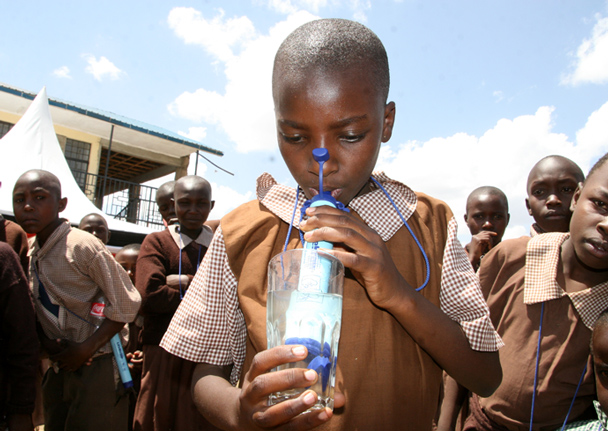A woman in Africa walks 3.5 miles to get water for her family, each member of which will need at least 2 gallons a day. Almost 1 in 3 people in Tajikistan rely on easily contaminated open ditches and canals for household water, putting them at risk for disease. Around the world, some 800 million people lack access to clean water to drink or cook with, according to official statistics from the World Health Organization (WHO) and the United Nations. And some experts estimate that the actual number of people using water that is unsafe might be closer to 1.8 billion. More than 2 million people still die each year from consuming contaminated water. And millions of people who live in water-insecure areas—whether in Asia or here in the United States—already depend on large-scale recycled or desalinated water supplies as part of their daily intake.
The millions who remain at the highest risk lack access to "improved" water sources, meaning that the crucial resource is not piped in or even collected from a protected spring or well. Thus these people are forced to use untreated and unprotected water for drinking, cooking, and washing. Though some of these dangerous sources are visibly dirty—surface water, or a muddy ditch, for example—other sources may look crystal-clear yet harbor hazardous bacteria, viruses, and parasites. Even water that is thoroughly clean when collected is frequently contaminated at home due to insufficient sanitation and hygiene. Tragically, children are the most vulnerable: Most of the illnesses and deaths caused by dirty water strike those under the age of 5, notes the WHO.
But today, technologies—some high-tech and some elegantly simple—are helping to bring safe water to people who have never had it. Thanks to innovations such as desalination, which is already in use in Asia, the Middle East, the United States, and elsewhere, and a wide range of filters, such as ceramic pots designed for at-home decontamination that are being made and used in Africa and South America, the world's drinking water crisis might finally be starting to dry up.
21st-Century Innovations for Individual and Community Use
For those across the globe still in need of a drink of clean water, many of the world's smartest minds are finding ingenious ways to make dirty water clean—and in some of the most challenging locations.
One such innovation derives from the age-old—and still common—practice of boiling water to disinfect it. Known as solar disinfection, a new approach is being championed by the WHO, Red Cross, and UNICEF, for individuals in at least two dozen countries, including remote, rugged areas in Guatemala, Kenya, and India. Refilling recycled plastic water bottles and leaving them laid horizontally undisturbed in the sun for a day can render water free of microbial contamination. UV-A rays kill off common bacteria such as E. coli. And if the water gets hotter than 122 degrees Fahrenheit, it can also inactivate any amoebas that can cause dysentery and other diseases that pose serious health threats, especially in regions of Africa where medical facilities are few and far between.
Susan Murcott, an engineering lecturer at the Massachusetts Institute of Technology, has been working for the past seven years in northern Ghana to increase the use of ceramic pot filters, which can filter out both microbial and sedimentary contamination using gravity. These pots are manufactured and sold locally and come with a safe water storage container and tap to minimize the chances for recontamination. Factories for these filters are now springing up elsewhere in Africa as well as in South America.
Other filtration technologies include LifeStraw, an oversize plastic straw that contains hollow fibers that function as filters, so a person can use it to drink directly from a microbially contaminated water source. The straw can satisfy one person's drinking-water needs for about a year before the filters get clogged (filtering approximately 264 gallons of water). A larger, gravity-based version can clean water for a family on any continent to meet U.S. EPA standards, and an even bigger iteration for use in schools is currently in the works.
More complex chemistry is also being used to clean water for millions—many of whom live in politically unstable or hard-to-reach areas of South Sudan, Rwanda, and Ethiopia. For example, PUR, a brand better known for first-world home filters, developed a powder that contains safe iron sulphate and calcium hypochlorite. These compounds kill bacteria and viruses, which then clump together with any dirt and particulate matter that are in the water, making it easy to remove or filter out. One packet can clean 2.5 gallons of water in about half an hour.



 Pinterest
Pinterest


